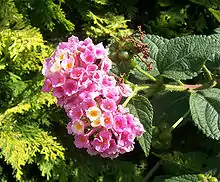Verbenaceae
The Verbenaceae (/ˌvɜːrbəˈneɪsi.iː/ VUR-bə-NAY-see-ee), the verbena family or vervain family, is a family of mainly tropical flowering plants. It contains trees, shrubs, and herbs notable for heads, spikes, or clusters of small flowers, many of which have an aromatic smell.[2]
| Verbenaceae | |
|---|---|
 | |
| Flowers, fruit and leaves (on the right) of a Lantana cultivar | |
| Scientific classification | |
| Kingdom: | Plantae |
| Clade: | Tracheophytes |
| Clade: | Angiosperms |
| Clade: | Eudicots |
| Clade: | Asterids |
| Order: | Lamiales |
| Family: | Verbenaceae J.St.-Hil. |
| Synonyms[1] | |
| |
The family Verbenaceae includes 32 genera and 800 species.[3] Phylogenetic studies[4] have shown that numerous genera traditionally classified in Verbenaceae belong instead in Lamiaceae. The mangrove genus Avicennia, sometimes placed in the Verbenaceae[5] or in its own family, Avicenniaceae,[6] has been placed in the Acanthaceae.[7]
Economically important Verbenaceae include:
- Lemon verbena (Aloysia triphylla), grown for aroma or flavoring
- Verbenas or vervains (Verbena), some used in herbalism, others grown in gardens
Taxonomy
_W_IMG_9162.jpg.webp)
_W_IMG_9874.jpg.webp)
Tribes and genera in the family[8] and their estimated species numbers:[3]
Casselieae (Schauer) Tronc.
Citharexyleae Briq.
- Citharexylum L. (fiddlewoods) - 60 species
- Rehdera Moldenke - 3 species
Duranteae Bent.
- Bouchea Cham. - 13 species
- Chascanum E.Mey - 27 species
- Duranta L. - 31 species
- Recordia Moldenke - 2 species
- Stachytarpheta Vahl - 120 species
Lantaneae Endl.
- Aloysia Palau (beebrushes) - 36 species
- Burroughsia Moldenke - 2 species
- Coelocarpum Balf.f. - 6 species
- Diphyllocalyx (Griseb.) Greuter & R.Rankin - 6 species
- Isidroa Greuter & R.Rankin - 1 species
- Lantana L. (shrub verbenas, lantanas) - 100 species
- Lippia L. - 140 species
- Nashia Millsp. - 1 species
- Phyla Lour. (frogfruits) - 5 species
Neospartoneae Olmstead & N.O'Leary
- Diostea Miers - 1 species
- Lampayo Phil. ex Murillo - 3 species
- Neosparton Griseb. - 3 species
Petreeae Briq.
Priveae Briq.
Verbeneae Dumort.
- Glandularia J.F.Gmel. - 88 species
- Hierobotana Briq. - 1 species
- Junellia Moldenke - 38 species
- Mulguraea N.O’Leary & P.Peralta - 11 species
- Verbena L. (verbenas/vervains) - 57 species
Unassigned
- Dipyrena Hook. - 1 species
- Rhaphithamnus Miers - 2 species
Excluded genera
Various genera formerly included in the family Verbenaceae are now treated under other families:[9]
- Moved to Acanthaceae
- Avicennia L.
- Moved to Lamiaceae
- Amasonia L.f.
- Brachysola (F.Muell.) Rye
- Callicarpa L.
- Caryopteris Bunge
- Chloanthes R.Br.
- Clerodendrum L.
- Congea Roxb.
- Cornutia L.
- Cyanostegia Turcz.
- Dicrastylis J.Drumm. ex Harv.
- Discretitheca P.D.Cantino
- Faradaya F.Muell.
- Garrettia H.R.Fletcher
- Glossocarya Wall. ex Griff.
- Gmelina L.
- Hemiphora (F.Muell.) F.Muell.
- Holmskioldia Retz.
- Hosea Ridl.
- Hymenopyramis Wall. ex Griff.
- Kalaharia Baill.
- Karomia Dop
- Lachnostachys Hook.
- Mallophora Endl.
- Monochilus Fisch. & C.A.Mey.
- Newcastelia F.Muell.
- Oncinocalyx F.Muell.
- Oxera Labill.
- Peronema Jack
- Petitia Jacq.
- Petraeovitex Oliv.
- Physopsis Turcz.
- Pityrodia R.Br.
- Premna L.
- Pseudocarpidium Millsp.
- Pseudocaryopteris P.D.Cantino
- Rotheca Raf.
- Schnabelia Hand.-Mazz.
- Spartothamnella Briq.
- Sphenodesme Jack
- Symphorema Roxb.
- Tectona L.f.
- Teijsmanniodendron Koord.
- Teucridium Hook.f.
- Tripora P.D.Cantino
- Vitex L.
- Moved to Oleaceae
- Dimetra Kerr
- Nyctanthes L.
- Moved to Orobanchaceae
- Asepalum Marais
- Cyclocheilon Oliv.
- Nesogenes A.DC.
- Moved to Phrymaceae
- Phryma L.
- Moved to Stilbaceae
- Campylostachys Kunth
- Euthystachys A.DC.
- Stilbe P.J.Bergius
- Thesmophora Rourke
References
- "Family: Verbenaceae J. St.-Hil., nom. cons". Germplasm Resources Information Network. United States Department of Agriculture. 2007-04-12. Archived from the original on 2012-09-15. Retrieved 2011-10-10.
- Stevens, P. F. (July 12, 2012). "Verbenaceae". Angiosperm Phylogeny Website. Retrieved September 24, 2013.
- Cardoso PH, O'Leary N, Olmstead RG, Moroni P, Thode VA (2021). "An update of the Verbenaceae genera and species number". Plant Ecology and Evolution. 154 (1): 80–86. doi:10.5091/plecevo.2021.1821.
{{cite journal}}: CS1 maint: multiple names: authors list (link) - Cantino, P.D., Harley, R.M. & Wagstaff, S.J. 1992. Genera of Labiatae: status and classification. Pp. 511-522. In Harley, R.M. & Reynolds, T. (eds) Advances in Labiate Science. Richmond, Royal Botanic Gardens, Kew.
- Grandtner, Miroslav M. (2005). Elsevier's Dictionary of Trees: With Names in Latin, English, French, Spanish and Other Languages. Vol. 1. Elsevier. p. 88. ISBN 978-0-444-51784-5.
- Nelson, Gil (1994). The Trees of Florida: a Reference and Field Guide. Pineapple Press. p. 52. ISBN 978-1-56164-055-3.
- "Angiosperm Phylogeny Website - Lamiales". Missouri Botanical Garden. Retrieved September 24, 2013.
- Marx H, O’Leary N, Yuan Y, Lu-Irving P, Tank DC, Múlgura ME, Olmstead, RG (2010). "A molecular phylogeny and classification of Verbenaceae". American Journal of Botany. 97 (10): 1647–1663. doi:10.3732/ajb.1000144. PMID 21616800.
{{cite journal}}: CS1 maint: multiple names: authors list (link) - "GRIN genera sometimes placed in Verbenaceae". Germplasm Resources Information Network. United States Department of Agriculture. Archived from the original on 2004-11-18. Retrieved 2011-10-10.
External links
 Media related to Verbenaceae at Wikimedia Commons
Media related to Verbenaceae at Wikimedia Commons Data related to Verbenaceae at Wikispecies
Data related to Verbenaceae at Wikispecies- Verbenaceae of Mongolia in FloraGREIF Archived 2016-03-03 at the Wayback Machine
- Verbenaceae in BoDD – Botanical Dermatology Database
